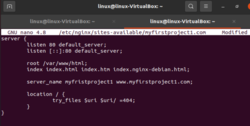today's howtos
-
Configure Lets Encrypt Digital Ocean
A website’s domain must have SSL/TLS encryption if it intends to get visitors. SSL/TLS certificates provide a strong connection among web servers and browsers. Earlier, security wasn’t a major concern. It was relatively common for websites to deliver data via the established HTTP protocol. Nowadays, the channel used to communicate with the server must be secured, though, because cybercrimes including identity theft, credit card fraud, and espionage are on the rise.
A Certificate Authority (CA) called Let’s Encrypt offers free SSL/TLS certificates, enabling HTTPS encryption on web servers. It is domain verified, so a dedicated IP Address is not necessary. It is usually advised to have an SSL certificate enabled on your website to improve your SEO ranking, particularly on Google.
-
How To Configure Mouse Support For Linux Virtual Consoles With GPM [Ed: Last updated today]
-
How to Manage RSS Feeds With Mozilla Thunderbird on Linux
Thunderbird is one of the best desktop email clients for Linux. It's fast, easy to use, and provides a range of features to simplify email management on your desktop. In addition, Mozilla also includes a few additional functionalities in the Thunderbird Mail client: chat, newsgroups, and syndication, which extend its scope of use further.
If you already use Mozilla Thunderbird for email management on your machine, you can now also access your latest news feeds and blogs within the same program. Here's how to use Thunderbird Mail as an RSS feed reader on Linux.
-
How to Live Monitor YouTube Views and Google Analytics With a Raspberry Pi
People who make YouTube videos or produce web content often set up dedicated displays to monitor performance statistics live, such as YouTube Analytics and Google Analytics. The live analytics data can give an insight of trending content, while the statistics can be used to quickly tweak and optimize related content.
In an ideal world, live monitoring should start at the flip of a power switch or the push of a power button on the television remote. A Raspberry Pi connected to a television or a monitor is ideal for this.
-
How to Install Jekyll Static Website Generator on Ubuntu 22.04
Jekyll is a free and open-source static file generator written in Ruby.
-
How to Install Graylog 4 on Ubuntu 22.04
Graylog is a free and open-source log monitoring tool used for capturing, storing, and enabling real-time analysis of terabytes of machine data.
-
How to Install Flatpak Packages on a Chromebook
Flatpak offers newer versions of apps than what you find by default on Chromebooks. Here's how to run the latest Linux software.
On most Chromebooks, you can install a complete version of Debian Stable under the Linux development environment. If you want access to newer apps, many popular Linux apps are available as Flatpak packages. It can be tricky to get such apps running on a Chromebook, but the process is easy when you know how.
-
How to Follow Symbolic Links in Linux
A symbolic link (also known as soft link) is a kind of shortcut to another file. It's heavily used in Linux for shared libraries.
But how do you know to which original file the link points to?
-
How to Fix Error: Failed to Download Metadata for Repo ‘AppStream’ from CentOS 8 - TREND OCEANS
If you are compelled to use CentOS 8 or have any other reason to have it still running on your system, Then I hope you know that CentOS 8 has died and reached its End Of Life (EOL) on December 31st, 2021.
-
How To Install SonarQube on Ubuntu 22.04 LTS - idroot
In this tutorial, we will show you how to install SonarQube on Ubuntu 22.04 LTS. For those of you who didn’t know, SonarQube or formerly Sonar is an open-source platform for static code analysis and code security. It can find the security vulnerabilities in more than 20 programming languages along with auto-analyzing code quality to detect code bugs and smells. SonarQube also provides reports such as duplicate code, coding standards, code complexity, and security recommendation.
This article assumes you have at least basic knowledge of Linux, know how to use the shell, and most importantly, you host your site on your own VPS. The installation is quite simple and assumes you are running in the root account, if not you may need to add ‘sudo‘ to the commands to get root privileges. I will show you the step-by-step installation of SonarQube on Ubuntu 22.04 (Jammy Jellyfish). You can follow the same instructions for Ubuntu 22.04 and any other Debian-based distribution like Linux Mint, Elementary OS, Pop!_OS, and more as well.
-
How to chat on Whatsapp on Linux with ZapZap
ZapZap is a beautiful, powerful Whatsapp client for Linux. It is an unofficial app with improved features like support for multiple users, integrated spellcheck, notifications, etc. Here’s how to chat on Whatsapp on Linux with ZapZap.
-
How to install Rancher Desktop on Linux and macOS | TechRepublic
Docker Desktop is one of the more popular GUI tools for developing and managing Docker containers. However, it’s not alone in the world of Docker GUIs. Although many Docker GUIs have come and gone, some have stood the test of time. One such GUI tool is Rancher Desktop.
-
How to enable Docker command completion in Linux to simplify the Docker CLI | TechRepublic
For some, Docker is second nature. The commands used are ingrained in their psyche. For others, however, it can be a chore to have to remember all those command line options. Is it docker image, docker images, or docker import? Given how complicated container deployment and management can be, the last thing you want is to have to remember every single command option available.

